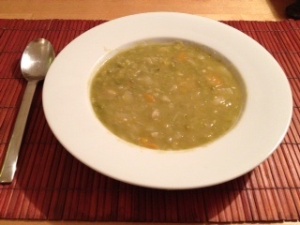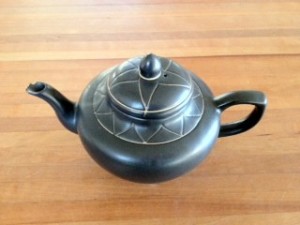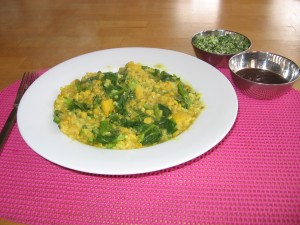
Vata: Neutral
Pitta: Neutral
Kapha: Decreases
Season: Spring
This salad dressing goes well with bitter and astringent greens and a handful of live sprouts. Be sure to moderate this recipe in the summer, as the pungent flavors may be too strong (garlic, ginger and black pepper). For a more centering (sattvic) dressing, omit the garlic and chives. When this is served over tender bitter greens (baby arugula, sprouts, dandelion greens and watercress) it can taste like a caesar dressing. (This recipe is adapted from Mira Murphy’s “Vegan Caesar Dressing.”) Salads for lunch can be extremely beneficial during the Spring (Kapha) season. Many people like juicing in the Spring, and this is an alternative way to have your juice―so you chew it. Pair this salad with unsweetened cranberry juice or a shot of fresh wheat grass juice and a wedge of orange. Your anti-oxidants will increase to help cleanse the auto-toxins (ama) of winter. Instead of using a fermented vinegar, the sour in this dressing comes from lemon which has a heating energy (virya) and a sweet post-digestive (vipaka) effect on the body (alkaline pH). In small quantities, “sour increases secretions and eliminates excess Kapha. It is refreshing, it energizes the body, nourishes the heart and enlivens the mind” (Dr. Vasant Lad). Let food be your medicine!
Ingredients:
- 1/2 cup water
- 1/2 cup olive oil
- 1/4 cup flaxseed oil
- 1/3 cup lemon juice
- 1 T black pepper
- 1 inch peeled fresh ginger (chopped)
- 1 T tahini
- 1 T miso (or add more tahini if you don’t have miso)
- 2 T Bragg’s liquid amino (or tamari or 1/2 t rock salt)
- 1 T honey
- 1 T Kelp or Dulse flakes
- Optional: 1 – 2 T chopped chives, 2 cloves garlic
Directions:
1. Mix all ingredients in a food processor or blender
2. Adjust pepper, salt and lemon to taste
3. Serve over bitter greens, radish, chopped carrots and celery
Serves: 8
Preparation time: 10 minutes
For Individual Doshas:
Vata: Sprinkle with sesame seeds or chia seeds.
Pitta: Add dill.
Kapha: Add a dash of cayenne and reduce salt.









